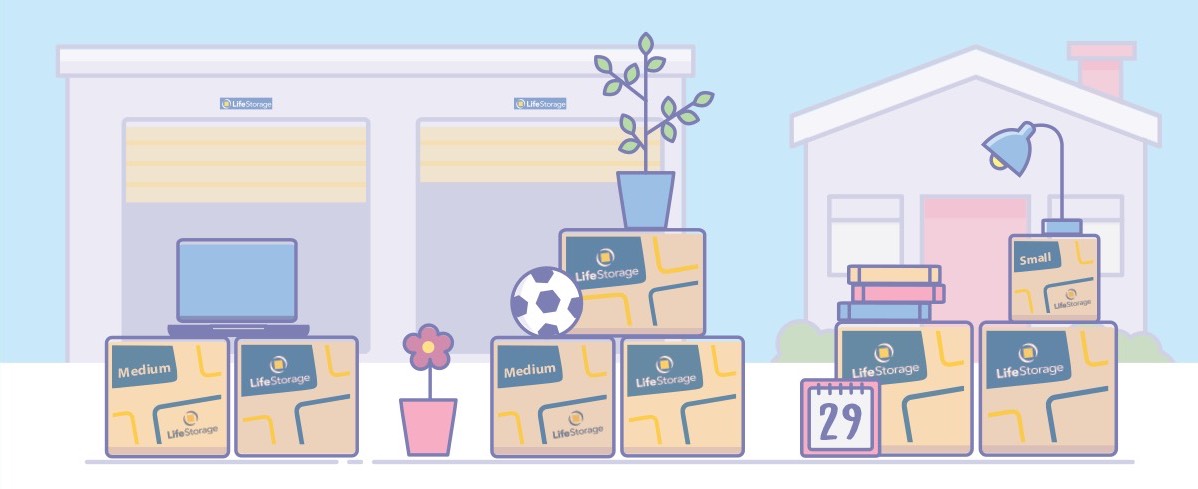
The Ultimate Moving Checklist
Moving can be overwhelming. There’s a LOT to think about and keep track of. You don’t want to forget something that’s going to end up stressing you out at the last minute or send your budget spiralling out of control.
This is where a moving checklist comes in – it’s invaluable for planning and staying on task during a relocation. Whether you’re moving out of state or into a new house around the block, use our interactive (and printable) moving guide to help you every step of the way.
Completed one of the items?  Check it off
Check it off
Need to remember something? ![]() Make a note
Make a note
Feel like something is missing? ![]() Add a new item
Add a new item
Getting Organized
8-10 weeks before the move
Planning The Move
6-8 weeks before the move
Decluttering
4-6 weeks before the move
Packing
2-4 weeks before the move
Getting Ready For The Move
1-2 weeks before the move
Moving Day
On the big day!
Settling In
1-2 weeks after the move
Getting started (ideally 10 weeks before the move)
Setting a budget (ideally 10 weeks before the move)
Moving out of the home or apartment you've been renting (ideally 10 weeks before the move)
Renting your new home or apartment (ideally 10 weeks before the move)
Preparing to move (ideally 8 weeks before the move)
Hiring a moving company (ideally 8 weeks before the move)
Moving DIY-style (ideally 8 weeks before the move)
Shipping a vehicle (ideally 8 weeks before the move)
Moving with children (ideally 8 weeks before the move)
Moving with pets (ideally 6 weeks before the move)
Moving to a new community (ideally 6 weeks before the move)
Storing items (ideally 6 weeks before the move)
Getting ready to travel (ideally 6 weeks before the move)
Decluttering your home (ideally 6 weeks before the move)
Preparing to pack (ideally 4 weeks before the move)
Starting to pack (ideally 4 weeks before the move)
Moving with children (ideally 4 weeks before the move)
Moving with pets (ideally 4 weeks before the move)
Storing items (ideally 2 weeks before the move)
Moving DIY-style (ideally 2 weeks before the move)
Moving with children (ideally 2 weeks before the move)
Shipping a vehicle (ideally 2 weeks before the move)
Finishing up odds and ends (ideally 1 week before the move)
Moving out of the home or apartment you've been renting (ideally 1 week before the move)
Renting your new home or apartment (ideally 1 week before the move)
Preparing for the move (ideally 1 week before the move)
Storing items (ideally 1 week before the move)
Managing movers (ideally 1 week before the move)
Managing movers (on the actual moving day)
Moving DIY-style (on the actual moving day)
Moving with pets (on the actual moving day)
Wrapping things up (on the actual moving day)
Moving out of the home or apartment you've been renting (on the actual moving day)
Get the lay of the land (ideally in the first few weeks after moving in)
Setting up your new home (ideally in the first few weeks after moving in)
Taking care of household tasks (ideally in the first few weeks after moving in)
Moving with pets (ideally in the first few weeks after moving in)
Updating your address (ideally in the first few weeks after moving in)
Settling into your new home (ideally in the first few weeks after moving in)
8-10 weeks before the move
6-8 weeks before the move
4-6 weeks before the move
2-4 weeks before the move
1-2 weeks before the move
On the big day!
1-2 weeks after the move
Getting started (ideally 10 weeks before the move)
Bookmark this page or print your checklist
You can download and print the PDF version of your checklist at any point during your move. BUT... if you want access to your checklist when you're on the go, then we recommend saving your checklist. Simply bookmark this page and come back to your checklist to keep ticking things off the list or adding notes along the way.
Block time in your calendar to prepare for the move
Moving takes waaaay more time than just moving day. Schedule time each day to work on collecting information and preparing for the move, then block off time around moving day once you have an idea of when that will be.
Coordinate moving/closing dates to the best of your ability
When it comes to locking in moving dates, you might not have much control... but if you do have a say in those dates, try to coordinate your move out date with your move in date so there's not too much of a gap, but still enough time to not have to rush. Keep in mind that if the dates are far apart, you may end up sleeping on a friend's couch for a bit.
Tip:
Try to give yourself plenty of time to move out of and clean your current home. Ideally, you'll be able to do this over a few days instead of all in a single day.
Setting a budget (ideally 10 weeks before the move)
Set a realistic moving budget
Print off a moving budget template, and get to work setting a budget. If money is tight, brainstorm some ways to save money during your move.
Tip:
Keep in mind that you may be able to deduct some moving expenses from your taxes.
Track your expenses
Once you have a budget, you need a system for tracking expenses throughout your move – for some, it's a spreadsheet; for others, it's an envelope stuffed with receipts. Whatever your speed, make time once a week to check on your expenses. This will allow you to adjust your spending as needed to stay within your moving budget.
Moving out of the home or apartment you've been renting (ideally 10 weeks before the move)
Review your lease agreement
Make sure you understand the obligations in your lease agreement for giving notice and getting your deposit back. Lease agreements usually contain a list of tasks you have to complete before moving out, so add those to your to-do list. (We have a fancy "Add new item" button for that.)
Notify your current landlord
You may have already given your landlord a heads up that you're leaving soon, but it's good to let them know exactly when moving day will be so you can get permission to put signs on the elevators and stairwells (if needed).
Renting your new home or apartment (ideally 10 weeks before the move)
Confirm with your new landlord when your rental will be ready
Remember to ask about cleaning and inspection to make sure any pre-existing damage is documented or fixed before you pick up the keys to the property.
Preparing to move (ideally 8 weeks before the move)
Contact insurance agents for both homes
Make sure your insurance at your current home is scheduled to stop on moving day an insurance of your new home is scheduled to start on moving day.
Let in-person service providers know you're moving
Make sure to notify housekeepers, landscapers, pool maintenance companies, snow plowers and anyone else who does routine in-person services at your current home. It's a courtesy to them and to your wallet – you don't want to accidentally pay for services after you've moved out.
Schedule time off work and notify your employer of an upcoming change of address
Make sure your employer is aware of where to send important documents.
Complete a change of address form and determine whether you need the USPS premium forwarding service
The USPS keeps a record of your old residential address and will automatically forward mail to your new address for six months. Don't wait on this one. Confirm when the forwarding service will take effect in case you need to check for mail at your previous address for a little while.
Change Social Security and Medicare mailing addresses
If you receive Social Security or Medicare benefits, you should update your mailing address online before moving.
Schedule a pest inspection
Does your new home have any pest issues? If so, you'll want to get an inspection done as part of the moving in process. Research some pest service providers and get that inspection scheduled.
Hiring a moving company (ideally 8 weeks before the move)
Research reputable moving companies
Start by researching local and interstate moving companies – read reviews and ask questions about things like insurance and estimated time vs. actual time (if the movers' estimates are notoriously optimistic, that's something you want to know) in order to figure out which company will be the best fit.
Get estimates from professional movers
Based on your research, narrow your choices down to three companies and start getting quotes. To give you an accurate quote, movers may come out to take a look at all your stuff, or ask you to complete a survey or send a video. Before agreeing to a quote, ask them what's not included so there are no surprises later in the process.
Pick your movers and sign a contract
Time to commit and make it official. Make sure everything is in writing. This is also a good time to secure moving insurance, especially if you're transporting valuable items.
Moving DIY-style (ideally 8 weeks before the move)
Make sure your helpers are available
Make sure everyone is on the same page about moving day, and confirm what vehicles they're bringing.
Determine the right size truck rental
The last thing you want is to have to make an unplanned extra trip because you've got more boxes than truck space – or to have your belongings sliding all over the place in the back of a mostly empty truck. To avoid these delightful scenarios, make sure you pick the right size moving truck. If possible, call the truck rental company and ask for their recommendation based on how many rooms' worth of stuff you're hauling.
Understand your insurance options
Insurance is important, but before paying for coverage you don't need, check your auto policy to see what it covers. That will help you gauge how much additional coverage to purchase from the truck rental company.
Figure out whether you need to rent additional equipment
Hello, dolly! Too many DIY movers don't have the equipment they need to make the process faster and easier – think dollies, ties, and furniture pads. Take this into consideration when shopping for a moving truck company. Many offer additional equipment, but it may cost extra.
Book a moving truck rental
Book it for half a day more than you think you need in order to give your crew some breathing room. The last thing you want is to be racing the clock at the end of an already exhausting day.
Check state transportation requirements
Depending on the distance of your move, you may find yourself in a state that requires trucks to stop for weighing. While planning your route take a few minutes to call the Department of Transporation in the state(s) you are traveling through to understand the expectations based on the size of your truck.
Shipping a vehicle (ideally 8 weeks before the move)
Research car shipping companies
Car shipping companies need more advanced notice than moving companies, so don't wait to make a decision.
Ask for proof of insurance
It's common to ask for proof of insurance when hiring a car shipping company. You also want a breakdown of what the company covers and does not cover if your car is damaged in transport.
Check your own auto insurance policy
Check your own auto insurance policy to see whether shipping is covered. You may need to spend a little more to get auto transport insurance, which is worth it – especially if your vehicle is traveling a significant distance.
Book a car shipping company
Make sure everything is in writing – not just a description of your car or how far it's going, but also things like the pickup and drop-off locations, specific times, and the insurance coverage. A big-ticket item like your car is not something to be vague about.
Have an extra set of keys on hand
Keep your second set of keys with you. If you don't have a second set, ask your local dealer to make you a copy. (And remember to make room for it in the budget.)
Moving with children (ideally 8 weeks before the move)
Discuss the move with your kids
Moving can be tough on a little one. Get your kids excited about the big move now so they have time to process the major changes coming down the pike. Not sure how to break the news to them or calm their anxiety – Parents.com offers some moving advice for families that may help.
Research childcare and schools in your new community
Sometimes schools and childcare facilities have waiting lists – don't wait until you're in your new community to start shopping around. Be sure to call prospective caregivers (and visit in person, if you're able).
Register for school
Registering your kids for school will allow them to start getting excited about what their new school offers. Visit the website together, or go in person if you're nearby.
Finalize moving day childcare
If your children are young, you may want them out of the way – erm, happily insulated from the hectic moving environment. Plan a sleepover at a friend's or grandparent's house, arrange for professional care, or at least prepare a few activities to keep them busy. Coloring books, iPads and board games can make the day fly by while keeping the kids out of your hair.
Moving with pets (ideally 6 weeks before the move)
Research pet transporation
Depending on whether your pet is traveling by car or by airplane, you may need a travel pet carrier.
Take your pet to the vet
If you are changing vets, go see your current vet one more time to make sure your pet is up to date on their shots. While you're there, ask your vet about how to keep your pet safe and comfortable during the move. Should you consider a mild sedative to help them stay calm?
Request copies of vet records and get any necessary medications
If you are changing vets, request copies of their medical history – this will make the transition to a new vet much easier. Also request enough of your pet's medications to get them through the move AND the unpacking stage.
Research a new vet
If you need to find a new vet for your pet, start this process now. Be sure to check out online reviews if you can't visit in person.
Get new ID tags and update the address on your microchip (if applicable)
ID tags help ensure your pet always finds their way home – including your new home. Before heading out, get tags made with your new address so that you can swap them in as soon as you arrive in your new community. Also, if your pet is microchipped, make sure to contact the company to update your address.
Finalize pet arrangments
Whether your pet is flying to your new home or staying with friends while you move, now's the time to nail down the details. Before the stress of moving really sets in, make a list of all the items your pet will need while in care or transit. Pets can sense the stress of move too!
Moving to a new community (ideally 6 weeks before the move)
Research your new community
Familiarize yourself with your new neighborhood by figuring out how to get around. Visit local restaurants and landmarks (in person or via Google Maps). Join community groups on social media and don't be afraid to ask for recommendations – finding the best pizza in town is important, especially for that first night in your new place when your kitchen is still full of boxes.
Update your memberships to community organizations, subscription services, gyms and clubs
Make the needed changes to any memberships so when you are settled in you can access the services you want right away.
Tip:
You might not be able to update all of these before your move, but as you're going through your list make note of the one you'll need to follow up with post-move.
Find a new doctor, dentist and pharmacy
Taking the time to research providers before moving day will be easier than doing so when you're settling in to a new neighborhood and getting lost among piles of unpacked boxes. It's also nice to know you have somewhere to turn in case you get sick.
Forward medical records and prescriptions
Don't hesitate to call your current doctor for advice about transferring prescriptions and medical records to your new providers.
Make a point to say goodbye
If you are moving away from your family and friends, you may want to plan a little going away get-together. This is something you could organize before you pack everything up, or ask a friend to help you host. Either way, make plans now for one last hurrah.
Storing items (ideally 6 weeks before the move)
Figure out what you need to store and how much space you need
Most storage companies give the dimensions of their storage units online. They may also have information to help you figure out what size unit you need based on the amount of stuff you have. If not, call and ask to ensure that you're only paying for what you need.
Research reputable self storage companies
Once you have a list of what you need to store, you can start to research compaines. Get quotes from three of them and check online reviews. Be sure to look into their size options, contact-free move-in options, security, hours of operation and climate control. There's more to consider than you might think.
Consider purchasing insurance
Find out whether your existing insurance for the items you plan to store will cover those items if they are off-site. If not, you may need to buy more coverage.
Getting ready to travel (ideally 6 weeks before the move)
Make travel arrangements
If you're flying or renting a car, be sure those reservations are booked.
Take your vehicles in for a tune-up
Don't set off on a cross-country move without taking your car in for an oil change and checking that your inspection and registration are up to date. You may also want to get your tires checked/rotated too!
Decluttering your home (ideally 6 weeks before the move)
Dispose of hazardous household items like old paint and unused cleaning products
Look up local rules (and environmentally friendly options!) for disposing of items such as paint. It may be more complicated than you anticipate.
Return anything you borrowed from neighbors
Looking at you, Kramer.
Start eating everything!
Try to make meals with what you have in the fridge or the pantry to avoid throwing out a bunch of food on moving day.
Clear out storage spaces
If you already have storage spaces, visit each one and declutter as much as possible.
Delete unnecessary computer files, and then make sure everything is backed up to a cloud or external hard drive
This is a great time to label your folders and hard drives so that when you go looking for that family photo, you can find it in five minutes and not five days!
Sort all your clothing, toys, books, games, and all other houseware items
Go Marie Kondo style on your belongings. Kondo's first rule is to tidy by category – deal with every single one of your books at once, for example. Separate items for frequent use, storage, trash, and donation or resale using the four-box technique.
Sell the items you don't need
Plan a weekend garage sale to make a little more cash for your move, or post individual items on an online marketplace. Too much going on? It's OK if you end up donating these items instead.
Take donation items to a donation center
Start by making a list of the donation centers nearest you, then check the drop-off hours and process to make sure you don't create more work for yourself. Some organizations will come to you!
Preparing to pack (ideally 4 weeks before the move)
Pick up moving boxes
Take a quick inventory of the items in your home and determine how many moving boxes you'll need. Purchasing new boxes is ideal because the cardboard isn't compromised in any way. To save money, ask your neighbors if they have any unused boxes. Get specific boxes for fragile items and clothing for ease of packing and moving. (Read more tips on moving boxes here.)
Print off moving box labels
Before you start packing, create moving labels by room and item. (Try our moving box label templates!)
Tip:
Once a box is packed, place the moving label on the upper right-hand corner of each side of the box. That way it will be visible even when other boxes are stacked on top.
Organize important documents and valuables
As you pack, remember to keep important papers and valuable items separate. Make a plan for how you will move things like birth certificates, jewelry and cash – ideally not in a box in the far corner of the moving van you won't be riding in.
Inventory all your valuables
Make a list of your valuables for insurance purposes, and to ensure once you arrive that all your valuables made the move.
Start a moving box inventory
A moving box inventory is a spreadsheet or list that you can use to keep track of which items are in which boxes. Here's how to start one: Create a page for each room in your new home. Assign a number to every box you pack. Record that number in your inventory list and jot down notes about what the box contains. If you need to find something quickly after everything's packed, you will LOVE your past self for making this list. It'll also come in handy for making sure you've loaded and unloaded all your boxes on moving day. (Download our free moving printables kit for inventory templates, moving box labels, and more!)
Take photos of all electronics before unplugging them
This will help jog your memory when you're reconnecting things such as your TV and stereo.
Measure doorways and large furniture
Take the time to plan how you will move your more complicated items – you might need to remove doors or doorframes in advance of moving day. The last thing you want is to be frantically digging for a screwdriver the morning of.
Starting to pack (ideally 4 weeks before the move)
Prepare your furniture for the move
Dismantle and prep any furniture that you're not using at this point. There's no sense leaving your guest bedroom furniture or other rarely used items to the last minute. Besides dismantling large pieces, there are others ways you can plan to protect your furniture while moving.
Purchase travel essentials
Pick up travel-size toiletries, like contact solution and mouthwash. That way you can start packing up the rest of the toiletries you use daily.
Start packing items that you aren't using
The sooner you start to pack, the less stressful packing will be. Pick a room and pack everything inside that you won't need for the next month. Then pack up all storage spaces since they typically hold items that aren't used frequently. Start packing decor and out-of-season clothing. Pack excess dishes. (Consider using specific dish-packing boxes for these. Take care to wrap them correctly – and yes, there's a guide for that!)
Update your moving box inventory based on the boxes you've packed so far
If you've made significant progress, give yourself a round of applause and maybe a celebratory glass of wine. If not, check out some of these packing tips to inspire you. Keep on packing and take regular breaks.
Pack your first week's essentials
Set out boxes for your family's essentials – those things you will need to get by in the week during and after the move. The contents of these boxes will be highly personalized, but for the sake of everyone involved, you'll probably want fresh clothing and a toothbrush. Important documents, keys and medications should also be included. Here are some more ideas to get you started. Label these boxes for essentials and keep them open – you likely won't finish packing them until the day before you move.
Don't forget to take breaks!
Getting some rest will make sure you stay productive and help prevent burnout.
Moving with children (ideally 4 weeks before the move)
Pack essentials for your kids?
This list will vary by age, but think about all the essential items your kids will want access to during and after the move – things like a favorite outfit, a teddy bear, or a special cup. Having these items on hand will help them get comfortable in their new space.
Moving with pets (ideally 4 weeks before the move)
Pack essentials for your pets
Don't head out without a bag of essentials for your pet. At the very least, make sure you have a water dish, leash, treats and poop bags handy. Your furbaby may also have a special bed and toy that will minimize travel stress.
Storing items (ideally 2 weeks before the move)
Book a storage unit
Choose the winner from the companies you've researched and sign the agreement making sure you understand their cancellation policy and how to move-in.
Keep boxes and items that are going into storage separated
Put moving boxes and items headed to storage in a different area than the boxes going straight to your new home. This will help you keep everything organized as you prepare to move things into your storage unit.
Moving DIY-style (ideally 2 weeks before the move)
Reconfirm moving plans with your helpers
Though this might seem like overkill, dates and times occasionally get lost in translation – better safe than left all by yourself on moving day. Make a final call to confirm the moving date and time with your helpers.
Tip:
Make sure to secure a parking spot for the moving truck if you live in the city.
Moving with children (ideally 2 weeks before the move)
Create moving day activities
A little bit of prep can go a long way in keeping your kids busy and distracted during your move. Have a few moving day activities on hand like card games, coloring books, iPad games and new books to read.
Shipping a vehicle (ideally 2 weeks before the move)
Start using up the gas in your car
You should aim to have no more than a quarter of a tank of gasoline left in your vehicle – just enough for loading and unloading purposes. The company you're using to ship your car might have more specific directions, so check your contract.
Remove items from your vehicle
Since most auto transporters are concerned about weight restrictions, you may need to remove all your belongings. Don't leave anything valuable in your car when shipping it! Spare tires and jacks might go missing. Removing electronics and chargers will also help prevent theft during the trip.
Confirm pickup and drop-off locations
Before handing over the keys, confirm the pickup and drop-off locations. If you've signed up for door-to-door service, you'll need to make sure the car shipping company has the correct addresses and times.
Take photos of your car to document its condition
Be sure to document the current condition of your vehicle for insurance purposes. The goal is to take way too many photos from every angle, inside and out. Also gather paperwork and information about the condition of your vehicle from your most recent tune-up. That way if your car is damaged in transit, you'll be able to prove that the company was responsible, not you.
Finishing up odds and ends (ideally 1 week before the move)
Take out trash and recycling for the final time
Make sure the last of your trash and recycling are taken care of, whether it's through pickup or a trip to your local landfill. Don't leave it for the next folks to deal with.
Mow the lawn and clean the gutters
Leave your property tidy and groomed before turning in your keys. Depending on your budget, it might be easier to hire a local service than to tackle it yourself.
Remove oil and gas from lawnmowers and snowblowers
Before the movers come, make sure your outdoor equipment is ready to travel. The last thing you want is oil or gas spilling during the move.
Clean your space
This isn't a sweep-the-crumbs-off-the-counter-with-your-hand type of cleaning. This is a deep clean including windows, floors, carpets, appliances, closets and all kitchen cabinets. This will help mitigate any issues before your final walk-through.
Clean out the fridge
Cleaning out your fridge can be painful, especially if you have a lot of food that cannot be donated or eaten before you leave. Do your best to recycle jars and plastic – resist the urge to toss it all in the garbage.
Schedule utilities to be shut off and turned on
You don't want to coordinate utilities too far in advance in case your moving date changes, so make the calls now. While you're at it, transfer your cable and internet. Shop for a better deal in the process.
Moving out of the home or apartment you've been renting (ideally 1 week before the move)
Inspect your rental and fix damages
You may have agreed to a condition report before renting your current property, meaning some damage already existed. After an inspection, talk to your landlord about any further damages and come to an agreement about who's responsible for fixing them.
Ensure all bills are paid in full
If you owe money on utilities or taxes, your landlord has the right to use your deposit to cover these debts. To avoid this, make sure all your accounts are in good standing.
Renting your new home or apartment (ideally 1 week before the move)
Inspect your new rental with the landord
Make sure everything discussed in the first inspection has been addressed. It's much easier to get things like a broken oven fixed before you move in than after. Check lights, window sealings, paint touch-ups, etc.
Create a list of items to buy for the new place (but don't buy them yet)
Prioritize your list based on which items are most important to have on hand during the first month in your new home. If this is your first apartment, chances are you'll need to add a lot of things to this list.
Preparing for the move (ideally 1 week before the move)
Plan meals for the final week
Now's the time when grocery shopping should be very intentional. You don't want to purchase too much food that you'll ultimately have to move'or throw out. Meal plan so you can make use of leftovers. Try to eat as much perishable food from your fridge as possible during this last week. Opt for simple meals and paper plates so you can get the rest of your kitchen packed.
Tip:
Check out some great meal prep ideas!
Make a moving day playlist to enjoy while moving and unpacking
Complete last-minute packing
At this point, the bulk of your household items should be in moving boxes. Pack away any stragglers. Track down your essentials box and put it off to the side away from the other moving boxes.
Keep an eye on the weather
This can dictate some last-minute changes to how items are packed. For example, you may want to wrap blankets or tarps around your furniture so it doesn't get wet during the move.
Make sure your phone is charged
The last thing you want is a dead phone battery. Make sure your battery is charged and keep the charging cord and car charger with you to be safe.
Pack snacks and a cooler
Doesn't matter what the temperature is – moving will make you sweat. Pack drinks and snacks to keep everyone hydrated and sugared up.
Storing items (ideally 1 week before the move)
Pick up a lock / the keys to your storage space
Not all storage companies provide locks, so make sure you have a secure lock or have picked up the keys for your storage unit in preparation for your move.
Move anything that you need to store into your storage unit
Moving anything that you plan to store into your storage unit before the moving day will help avoid any confusion with your movers or helpers.
Managing movers (ideally 1 week before the move)
Have cash on hand
Cash will come in handy on moving day for tipping your movers and the pizza delivery person.
Managing movers (on the actual moving day)
Keep the movers on task
When the movers arrive, communicate your expectations so that everyone is on the same page. Plan a rough time to arrive at the new place and plan a time for everyone to break for lunch. You'll probably be paying by the hour, so it pays to keep movers on schedule.
Pay the movers
After a final inspection, review your invoice thoroughly and pay the movers. Don't forget to tip!
Moving DIY-style (on the actual moving day)
Keep helpers hydrated and fed
Make sure your family and friends have access to lots of water and snacks to keep up their energy. You may need to take charge and ensure they are taking breaks throughout the day.
Moving with pets (on the actual moving day)
Give your pet lots to drink
Be sure to stop and give your pet plenty of water throughout the day. Treats are always welcome too!
Feed your pet early
Some pets find travel stressful. To stave off stomach issues, feed your pet well in advance of your move. Usually, five hours will do the trick, allowing food to settle properly before an airplane or car ride.
Wrapping things up (on the actual moving day)
Double-check the house during the final walk-through
After your home is empty, do a final walkthrough to make sure nothing has been left behind. Keep a list and take photos of any damage that has taken place during the moving process.
Hand over the keys
Unless you're planning to come back after the move to tie up loose ends, go ahead and hand over the keys to your landlord or new owners.
Keep all your moving receipts
Keeping your moving receipts may help during tax time. Depending on why and how far you moved, you could save some cash!
Moving out of the home or apartment you've been renting (on the actual moving day)
Complete your final rental inspection with your landlord
After all your belongings are out of there and the place is clean, you will need to complete a final inspection with your landlord – and, hopefully, confirm that you're getting your deposit back.
Get the lay of the land (ideally in the first few weeks after moving in)
Make sure you have access to all facilities
Your new property may have laundry services, a fitness center or even a social room. Check the operating hours of all services, and make sure you have the fob, key code or whatever method of entry you need.
Setting up your new home (ideally in the first few weeks after moving in)
Decide how you want to organize your home before you unpack
Moving into a new home is an opportunity to undo any negative organizational habits you had in your last home. Learn how to keep your home organized and tidy as you unpack so that you don't end up putting things away twice.
Unpack
Don't rush this process. Make sure everything has a place before you remove stuff from boxes. Tackle the things you need first and then go room by room. You'll get it all done.
Pop some bubbly! Moving is not easy work
If Champagne is not your thing, celebrate with whatever is.
Purchase items for your new home
Earlier, you created a list of items you'd need when you moved in. Now's the time to purchase these items. If you're on a budget, buy just what is necessary for the time being. You don't need that new turntable right away.
Taking care of household tasks (ideally in the first few weeks after moving in)
Test smoke alarms
Testing your smoke alarms is a good idea. You may need new batteries – or additional smoke alarms.
Change the locks ASAP
You have no idea who might have a key to the existing locks, so get those changed pronto. Your realtor or landlord might be able to suggest a reputable local locksmith.
Figure out waste pickup details
Check your community waste and recycling pickup schedules and any special requirements you need to know.
Prepare a list of emergency service technicians and preferred providers
You might not need these folks anytime soon, but making a list now means you'll have it when you need it instead of frantically searching for a plumber as water rains from the ceiling. Think about electricians, plumbers, locksmiths, landscapers, roofers, handymen, storage, etc. Your realtor, landlord or local online community can help you make a list.
Moving with pets (ideally in the first few weeks after moving in)
Register your pet
If you're moving to a new county or state, you will need to register your pet. Timeline requirements for this will vary by state, but you should try to register your pets and purchase a license within a month of moving. This is mainly to ensure that animals receive all necessary shots for public safety purposes.
Updating your address (ideally in the first few weeks after moving in)
Register to vote at your new address
If you're unsure of how to register, visit Vote.gov to find out what the process is for your new state. In some states, you'll do this when you update your driver's license.
Update your mailing address (if you haven't already)
There may be a lot of places that need your new address. Start by creating a list of any business that still have your old address – think cell phone carrier, credit card companies, banks... Then block time to sit down and start making your way through the list – some you'll be able to do online, but for others you may have to call.
Register your car and change the address on your license
If you're moving to a new state, you'll need to register your car in the new state and get new license plates. Visit the website of your local DMV to find out what forms and fees are involved. When you go in to the DMV, you should look at updating the address on your driver's license as well.
Settling into your new home (ideally in the first few weeks after moving in)
Enjoy your new home
Hey – moving is a big deal! Find a way to mark the occasion with photos, social posts or a special dinner.
Meet the neighbors
Don't be a stranger! Introducing yourself is a kind gesture that can get life in your new neighborhood off to a good start.
Get involved in your community
If you want to give back to your new community by volunteering, do some research on VolunteerMatch to find opportunities in your area. If socializing is more up your alley, attend local events, fundraisers and gatherings in your community. You can also use Meetup to find social groups based on your hobbies or interests. Joining your neighborhood HOA board, signing up for a club membership, joining a sports team, or meeting up with your local college alumni group are some other ways to get involved in the community.
Recommended reading
Create a Realistic Moving Budget Using This Guide
![]() 5 min read
5 min read
![]() 1.3k shares
1.3k shares
Setting a moving budget is a vital step in the relocation process. This guide and free template will help you account for all the hidden costs associated with a move.
Get Organized For Your Move: Download Our Free Moving Printables Kit
![]() 5 min read
5 min read
![]() 6 shares
6 shares
You have enough to think about while planning for a move. Don't let yourself forget some crucial to-dos in the stress of it all. Download our free moving checklist and moving printables kit.
Who To Notify When Moving: Your Way To A Successful Move
![]() 5 min read
5 min read
![]() 181 shares
181 shares
If you want your move to go smoothly, you should notify important people and service providers beforehand. Taking care of this step prior to your move will pave the way for a successful transition. Here's where to start.
Save my checklist for later
Create a Life Storage Blog account to save your checklist progress and stay organized.
Easy Access
Saving your checklist will give you access to it whenever, wherever – whether you're at home or on the go.
15% off
Save up to 15% every month when you book your next storage unit online with Life Storage.
Create a custom moving checklist to be in full control of your move
Are you trying to plan a move for you and your family? Are you considering a furry family member? Do you need to ship a vehicle?
If you answered “yes!” to any of those, then our custom checklist might be a perfect fit for you!
- Tailor your checklist to your move (so you won't be distracted by items that don't matter to you)
- Save a digital version or download your printable moving checklist
New checklist item
Save your checklist to keep track of your progress. If you leave without saving, your changes will be lost forever.
- Make Payments
- Account Info
- Alerts


















































































































